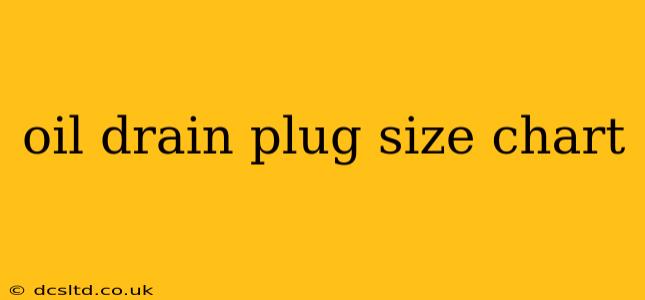Changing your car's oil is a crucial part of regular maintenance, ensuring your engine runs smoothly and lasts longer. A critical step in this process is knowing the size of your oil drain plug. This comprehensive guide provides a detailed oil drain plug size chart, along with answers to frequently asked questions to help you tackle this task with confidence. Finding the right size is essential to prevent leaks and damage.
What Size is My Oil Drain Plug?
This is the most common question, and unfortunately, there's no single answer. The size of your oil drain plug depends entirely on the make, model, and year of your vehicle. There's no universal oil drain plug size chart that covers every car ever made. To find the correct size for your car, consult your owner's manual. This manual provides detailed specifications, including the exact size and type of oil drain plug your vehicle uses.
Where Can I Find My Oil Drain Plug Size?
- Owner's Manual: This is the most reliable source. Look for sections on maintenance, oil changes, or specifications. The drain plug size will usually be listed along with other important information such as the type and quantity of oil required.
- Online Resources: Many websites and forums dedicated to specific car models have detailed information, including drain plug sizes. However, always double-check this information with your owner's manual to ensure accuracy.
- Vehicle Identification Number (VIN): Your VIN can be used to look up your vehicle's specifications online through various databases and parts websites. However, this method might not always yield the drain plug size directly.
- Mechanic or Dealership: If you're uncertain, a qualified mechanic or dealership service department can easily identify the correct size. They have access to detailed service manuals and can accurately determine the plug size for your specific vehicle.
What are the Common Oil Drain Plug Sizes?
While there's no universal size, some sizes are more common than others. These include:
- 14mm: A relatively common size for smaller engines.
- 17mm: Another frequently used size for many passenger cars.
- 19mm: Often found in larger engines or trucks.
- 21mm: Common in larger vehicles, SUVs, and trucks.
These are just examples, and the actual size will vary significantly. Remember, relying solely on these common sizes is risky; always verify with your owner's manual.
What Type of Oil Drain Plug Does My Car Have?
Besides size, the type of drain plug is also important. Common types include:
- Standard Hex Drain Plug: This is the most common type, featuring a hexagonal head that can be easily tightened or loosened with a wrench.
- Square Drain Plug: Less common than hexagonal, this type uses a square head.
- Magnetic Drain Plug: Some vehicles use magnetic drain plugs to help attract metal particles, keeping the oil cleaner.
Knowing the type of drain plug helps you choose the right tool for the job.
What Happens If I Use the Wrong Size Oil Drain Plug?
Using the incorrect size drain plug can lead to several problems:
- Leaks: The most common issue. A drain plug that's too small won't seal properly, leading to oil leaks.
- Stripped Threads: Forcing a wrong-sized plug can strip the threads in the oil pan, requiring more extensive repairs.
- Damage to Oil Pan: Incorrect installation could potentially damage the oil pan itself.
Therefore, using the correct size and type of drain plug is paramount.
How Often Should I Change My Oil?
The frequency of oil changes depends on several factors, including the type of oil used, your driving habits, and your vehicle's recommendations. Consult your owner's manual for the recommended oil change intervals. Regular oil changes are essential for engine longevity.
This guide aims to provide a thorough understanding of finding the right oil drain plug size. Remember, always consult your owner's manual for the most accurate information. If you have any doubts, seeking professional help is always the best course of action.
